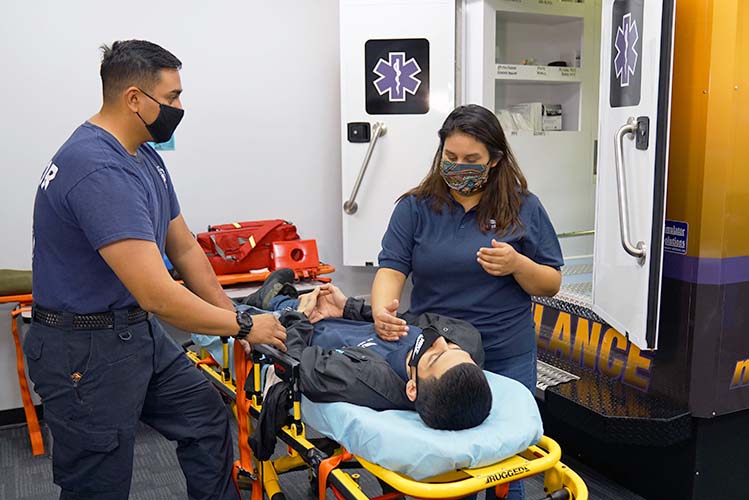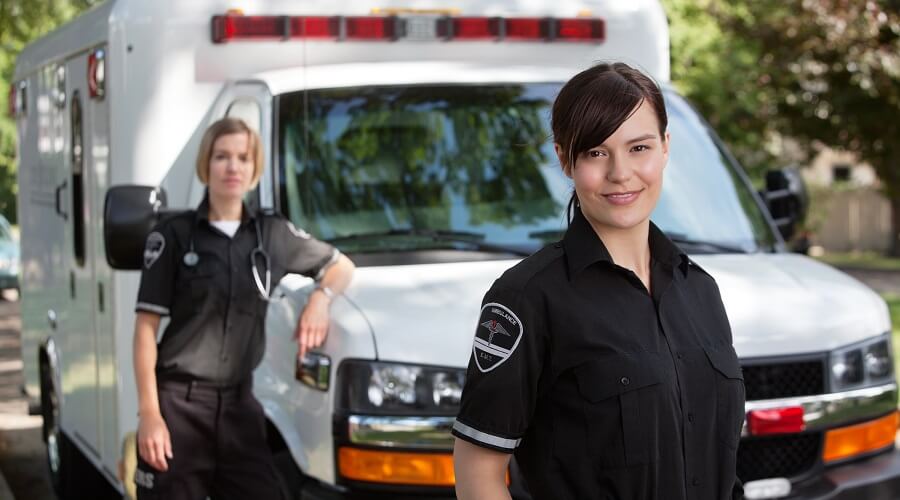REQUEST MORE INFORMATION
Ready to Make a Change? Get Started Today! Book a Campus Tour >
Are you passionate about helping others in emergency situations? Do you thrive in high-pressure environments where quick thinking and decisive action can make a life-changing difference? If so, becoming an Emergency Medical Technician (EMT) might be the perfect career path for you. In this comprehensive guide, we will walk you through the steps that you need to take to become an EMT in California and why you should choose US Colleges to become an Emergency Medical Technician (EMT).
If you're interested in becoming an EMT, consider enrolling in US Colleges' EMT Training Program. The program is short-term and does an excellent job of providing you with the knowledge and skills you need to succeed in the field.
How to Become an EMT in California?
Step 1: Understanding the Role of an EMT
An Emergency Medical Technician (EMT) is a healthcare professional who provides immediate medical care to individuals in need. They are often the first responders in emergency situations, and their quick assessment and intervention can be critical in saving lives. EMTs are trained to provide basic medical care, perform CPR, control bleeding, and stabilize patients for transportation to medical facilities.
Step 2: Earn a High School Diploma & Be 18 Years of Age
To become an EMT in California, you must be at least 18 years old, and you must have earned a high school diploma or equivalent. Also, some employers may require that you have a valid driver’s license.
Step 3: Enroll in & Complete an Approved EMT Program
The third step to becoming an EMT is to complete an approved EMT training program. US Colleges offers a comprehensive EMT program that provides hands-on training, theoretical knowledge, and practical skills development. Our experienced instructors will guide you through essential subjects such as emergency medical services, patient assessment, trauma care, and medical emergencies.
Step 4: Sit for and Pass the NREMT Exam
The fourth step you must take to become an EMT in California is to sit for and pass the National Registry of Emergency Medical Technicians (NREMT) exam. After completing the training program, you must pass the NREMT exam to become a certified EMT. This exam evaluates your knowledge and skills in various emergency medical scenarios.
Step 5: Apply for California State Certification
Once you pass the NREMT exam, you will apply for EMT certification through the California Emergency Medical Services Authority (EMSA). This certification is necessary to work as an EMT in California. After earning the certification, you must maintain your certification. This involves renewing your certification every 2 years.
Exploring The Different Types of EMTs
EMTs can specialize in various areas of emergency medical care. Understanding the different types of EMT certifications can help you determine your career path.
Here are some common types of EMTs:
EMT-Basic (EMT-B)
This is the entry-level certification and allows you to provide basic medical care, administer CPR, control bleeding, and handle other essential tasks. EMT-Bs work under the guidance of paramedics.
Advanced EMT (AEMT)
With additional training, AEMTs can administer certain medications, use advanced airway devices, and perform more advanced medical procedures. AEMTs work as an intermediate level between EMT-Bs and paramedics.
Paramedics
Paramedics receive extensive training and have the highest level of prehospital care. They can perform advanced life support techniques, administer a wide range of medications, interpret electrocardiograms (ECGs), and make critical decisions in emergency situations.
What Does a Day in the Life of an EMT Look Like?
The life of an EMT is dynamic, challenging, and incredibly fulfilling. Every day brings unique experiences and the opportunity to make a difference in people's lives. As an EMT, you may respond to emergency calls, provide on-scene medical care, transport patients, and collaborate with healthcare professionals to ensure the best outcomes for patients. Your role as an EMT is critical in providing timely and effective care, often under high-pressure circumstances.
Do You Need a College Degree to Become an EMT?
No, a college degree is not typically required to become an Emergency Medical Technician (EMT). The educational requirements for EMT certification vary by state and level of certification. In most cases, EMT training programs are offered by vocational schools, community colleges, or specialized training centers.
US Colleges' EMT Training Program does NOT require a college degree.
EMT training programs generally consist of a combination of classroom instruction, hands-on skills practice, and clinical or field internships. The duration of these programs can range from a few weeks to several months, depending on the certification level (such as EMT-Basic or Paramedic) and the requirements set by the state or certifying agency.
While a college degree is not mandatory for EMT certification, some individuals may choose to pursue a degree in a related field, such as emergency medical services (EMS) or paramedicine, to enhance their knowledge and career prospects. Additionally, a college degree may be required for advanced levels of EMS training or for career advancement opportunities within the field.
It is important to note that specific requirements can vary by state and employer. It is advisable to research the requirements of the region where you intend to work as an EMT to ensure compliance with local regulations and preferences.
What Are the Duties and Responsibilities for Emergency Medical Technicians?
EMTs have the following duties and responsibilities:
- Responding to emergency calls and providing pre-hospital care to patients.
- Assessing the patient's condition, including vital signs, medical history, and nature of the illness or injury.
- Stabilizing patients and providing initial treatment at the scene of the emergency.
- Administering emergency medical treatments such as CPR, automated external defibrillation (AED), and oxygen administration.
- Assisting with childbirth and managing medical emergencies like severe bleeding or cardiac arrest.
- Immobilizing patients with spinal injuries using backboards, cervical collars, or other appropriate techniques.
- Administering certain medications or assisting with administering medications prescribed by medical control.
- Safely and efficiently transferring patients to medical facilities, ensuring their comfort and stability during transportation.
- Communicating patient information, vital signs, and observations to receiving medical personnel.
- Collaborating with other emergency responders and healthcare professionals to ensure seamless patient care.
- Accurately documenting patient information, assessments, interventions, and treatments provided.
- Completing incident reports and maintaining thorough and organized records of each patient encounter.
- Ensuring the readiness and functionality of emergency medical equipment, such as defibrillators, airway management devices, and ambulances.
- Participating in ongoing training, continuing education, and certification renewal to maintain proficiency in emergency medical techniques and protocols.
- Collaborating effectively with other healthcare professionals, emergency responders, and medical control personnel during emergencies.
Is Becoming an EMT Hard?
While becoming an EMT requires commitment and hard work, it is an achievable goal. The training can be intense, and the job itself can be challenging, but with the right training, support, and dedication, you can overcome the obstacles and embark on a rewarding career as an EMT. US Colleges is here to provide you with the guidance and resources you need to succeed.
Enroll in the US Colleges EMT Training Program
Ready to take the first step toward a fulfilling career as an EMT? Enroll in the US Colleges EMT program today! Our comprehensive curriculum, experienced faculty, and hands-on training will equip you with the skills and knowledge you need to excel as an emergency medical technician. By joining our program, you will be joining a community of passionate individuals who are dedicated to making a difference in the lives of others.
Becoming an EMT in California is a noble and fulfilling career choice. By following the outlined steps to becoming an EMT and enrolling in the US Colleges EMT program, you will gain the necessary skills, knowledge, and certifications to embark on this rewarding path. Join us today and make a difference in the lives of those in need.




